
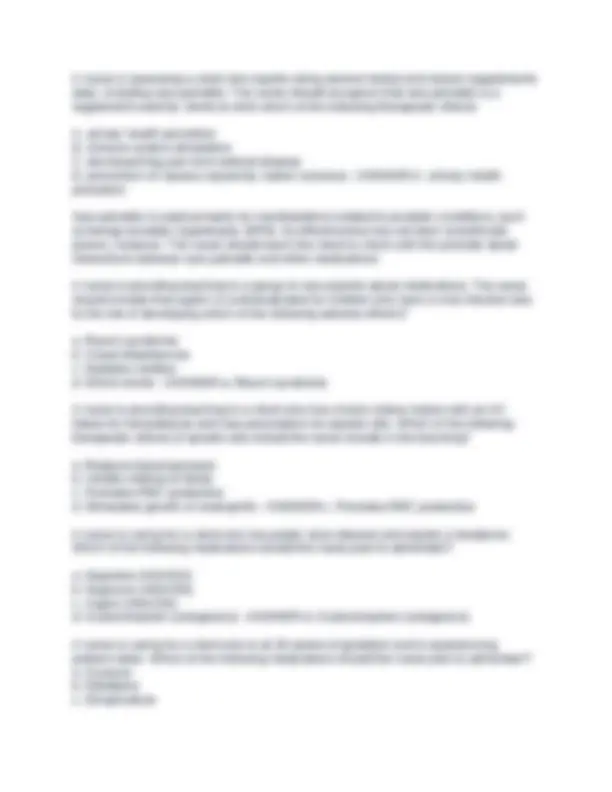
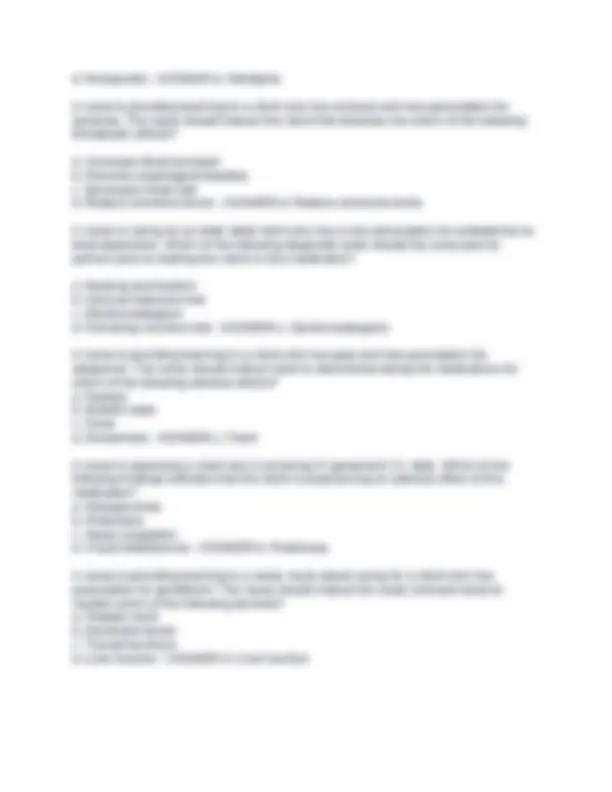
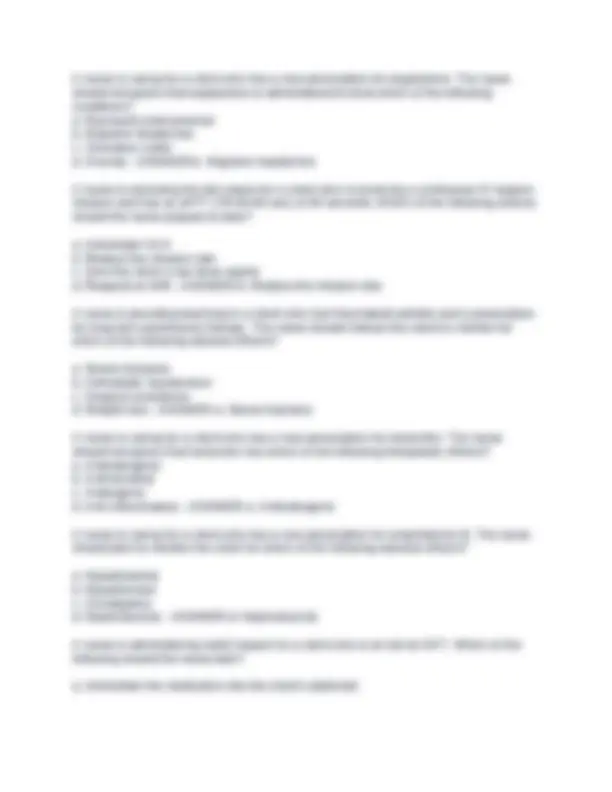
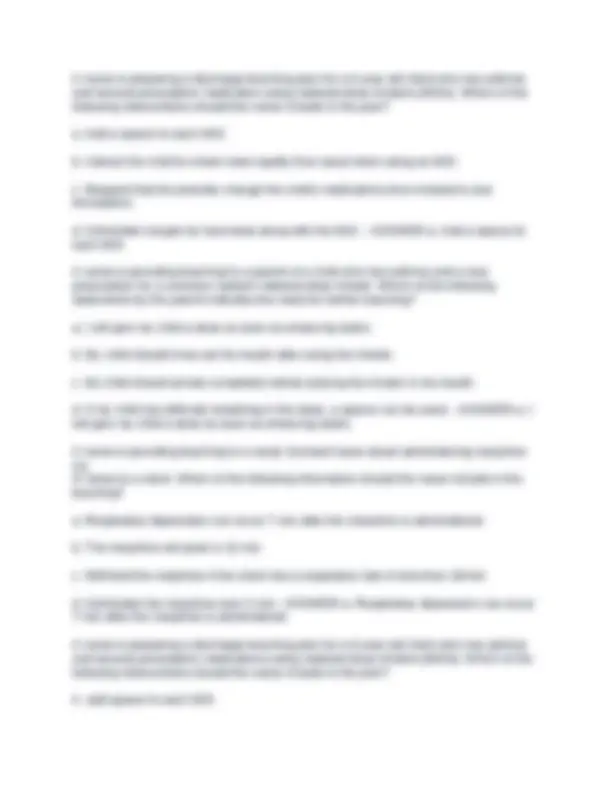
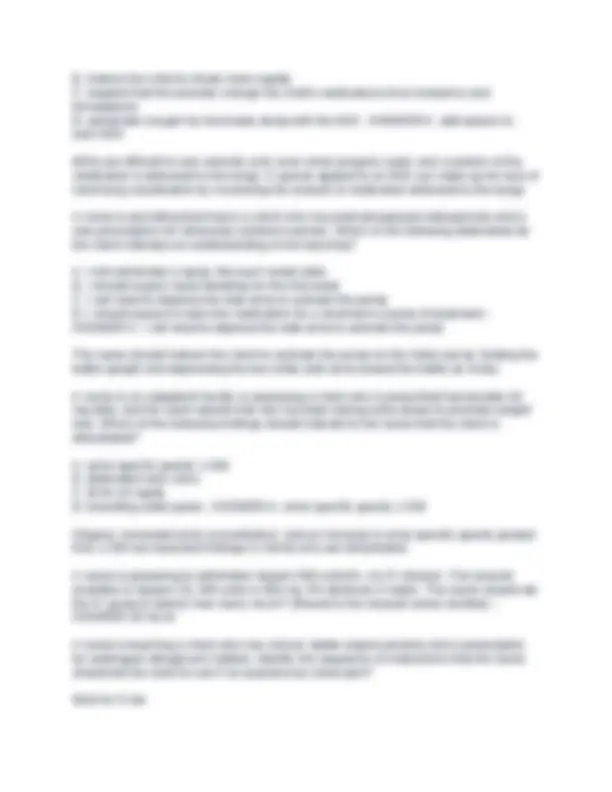
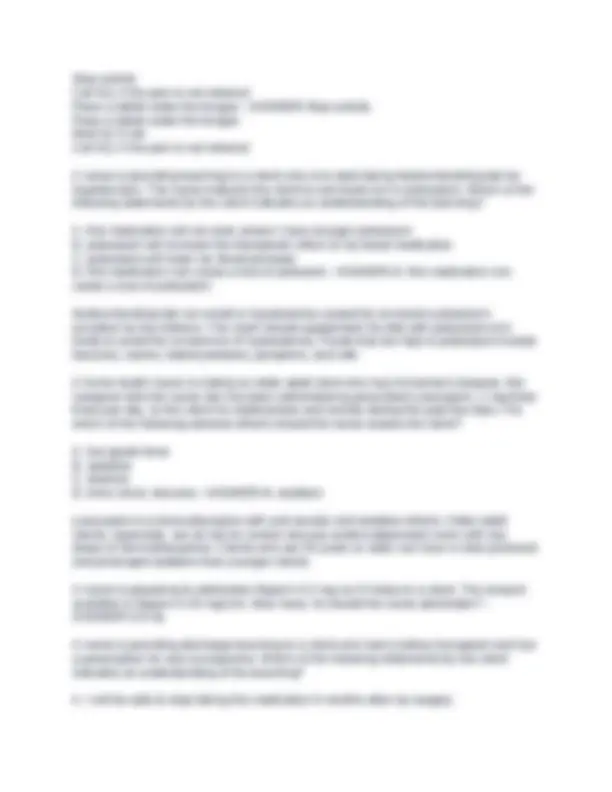

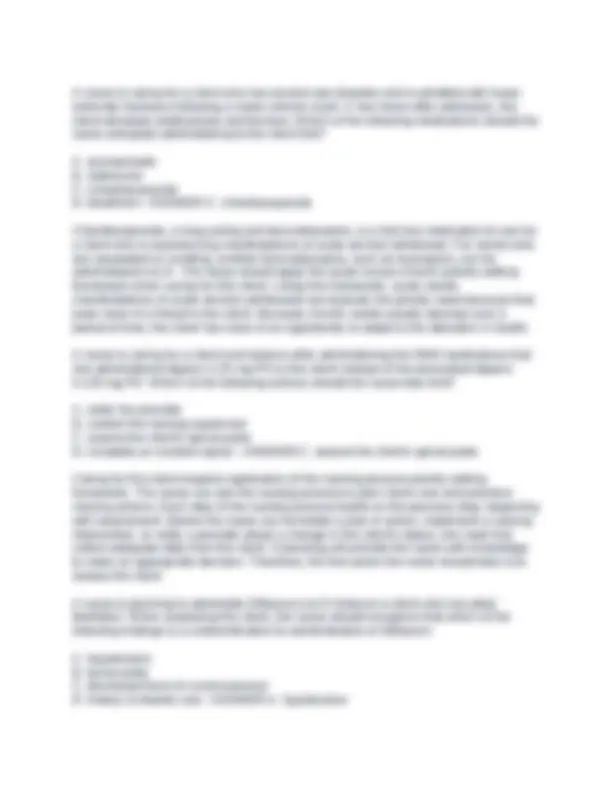
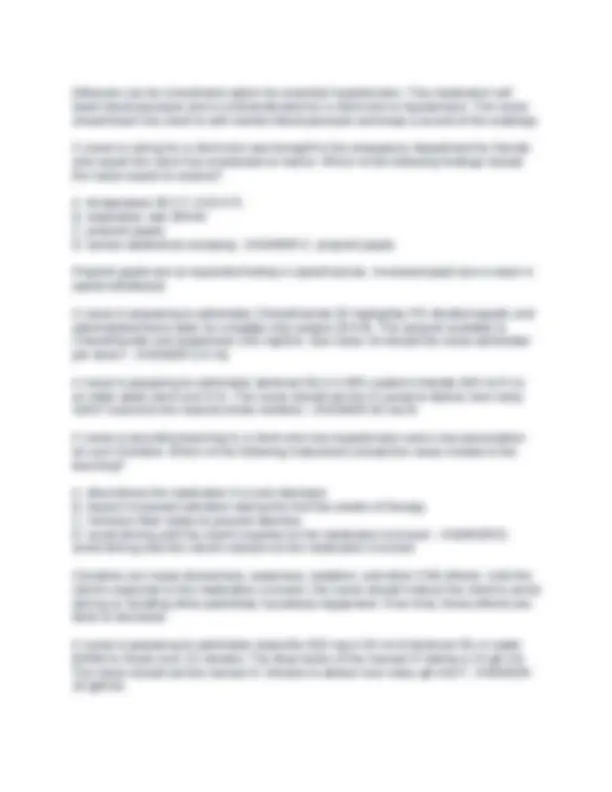
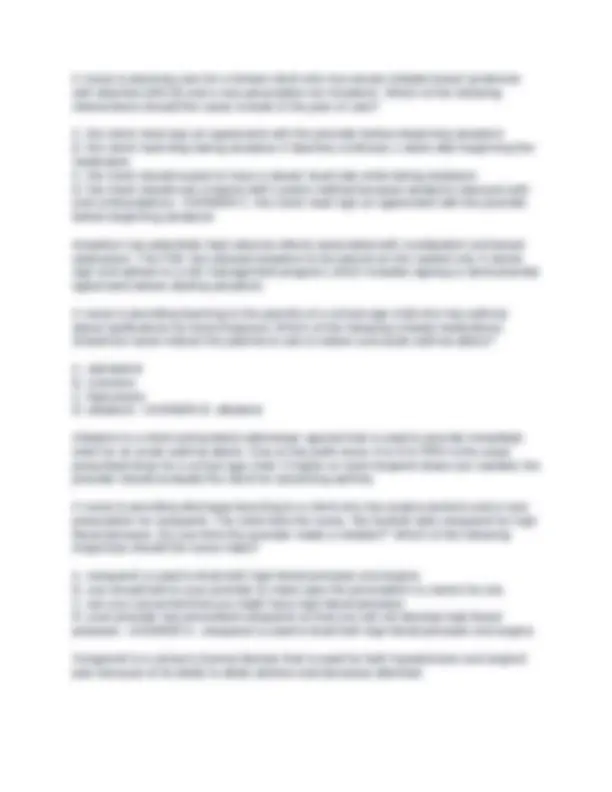
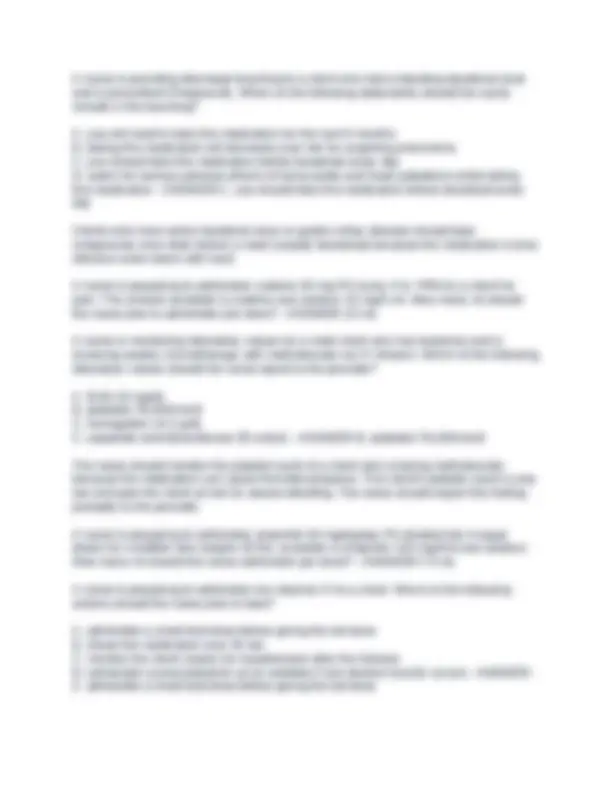
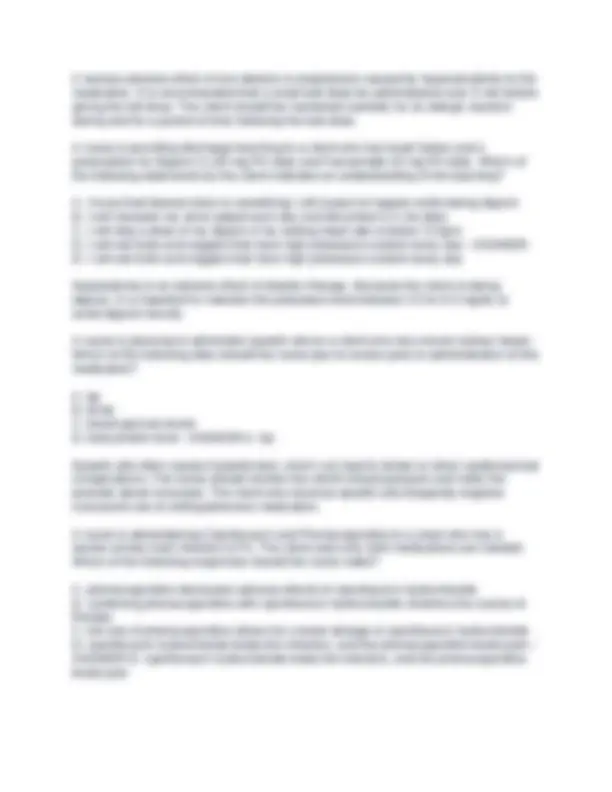
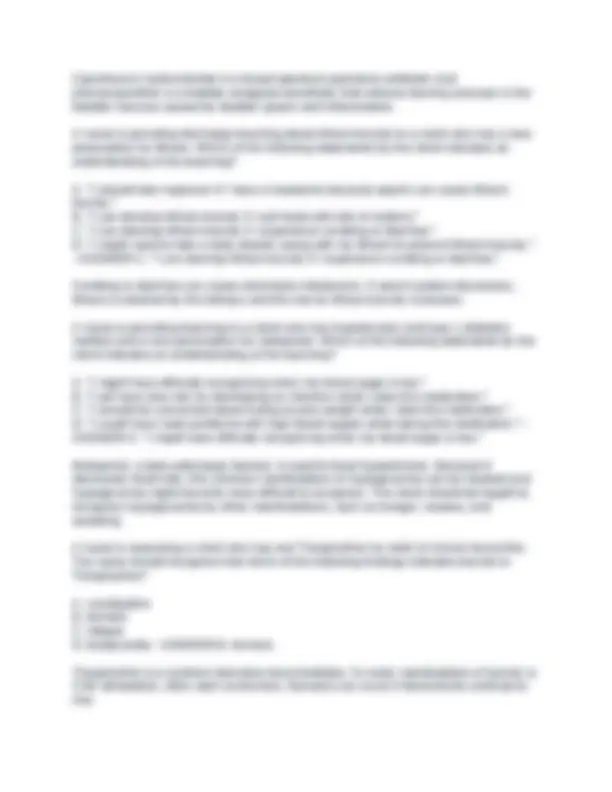
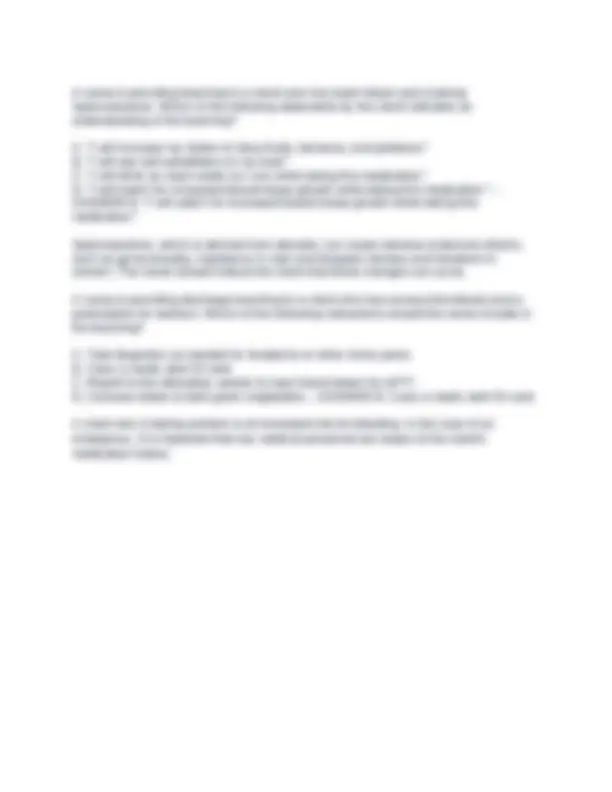


Study with the several resources on Docsity

Earn points by helping other students or get them with a premium plan


Prepare for your exams
Study with the several resources on Docsity

Earn points to download
Earn points by helping other students or get them with a premium plan
Community
Ask the community for help and clear up your study doubts
Discover the best universities in your country according to Docsity users
Free resources
Download our free guides on studying techniques, anxiety management strategies, and thesis advice from Docsity tutors
A nurse is caring for a client who has prescription for clopidogrel. The nurse should monitor the client for which of the following adverse effects? a. Insomnia b. Hypotension c. Bleeding d. Constipation - ANSWER-c. Bleeding A nurse is teaching a newly licensed nurse about contraindications to ceftriaxone. The nurse should include a severe allergy to which of the following medications as contraindication to ceftriaxone? a. Gentamicin b. Clindamycin c. Piperacillin d. Sulfamethoxazole-trimethroprim - ANSWER-c. Piperacillin A nurse is providing teaching to a newly licensed nurse about metoclopramide. The nurse should include in the teaching that which of the following conditions is a contraindication to this medication? a. Hyperthyroidism b. Intestinal obstruction c. Glaucoma d. Low blood pressure - ANSWER-b. Intestinal obstruction A nurse is assessing a client who has a new prescription for chlorpromazine to treat schizophrenia. The client has a mask
Typology: Exams
1 / 22

This page cannot be seen from the preview
Don't miss anything!















A nurse is caring for a client who has prescription for clopidogrel. The nurse should monitor the client for which of the following adverse effects? a. Insomnia b. Hypotension c. Bleeding d. Constipation - ANSWER-c. Bleeding A nurse is teaching a newly licensed nurse about contraindications to ceftriaxone. The nurse should include a severe allergy to which of the following medications as contraindication to ceftriaxone? a. Gentamicin b. Clindamycin c. Piperacillin d. Sulfamethoxazole-trimethroprim - ANSWER-c. Piperacillin A nurse is providing teaching to a newly licensed nurse about metoclopramide. The nurse should include in the teaching that which of the following conditions is a contraindication to this medication? a. Hyperthyroidism b. Intestinal obstruction c. Glaucoma d. Low blood pressure - ANSWER-b. Intestinal obstruction A nurse is assessing a client who has a new prescription for chlorpromazine to treat schizophrenia. The client has a mask like facial expression and is experiencing involuntary movements and tremors. Which of the following medications should the nurse anticipate administering? a. Amantadine b. Bupropion (aytpical antidepressant) c. Phenelzine (MAOI) d. Hydroxyzine (Antihistamine) - ANSWER-a. Amantadine A nurse is administering subQ epinephrine for a client who is experiencing anaphylaxis. The nurse should monitor the client for which of the following adverse effects? a. Hypotension b. Hyperthermia c. Hypoglycemia d. Tachycardia - ANSWER-d. Tachycardia
A nurse is providing teaching to a client who has UTI and new prescription for phenazopyridine and ciprofloxacin. Which of the following statements by the client indicates the need for further teaching? a. If the phenazopyridine upsets my stomach, I can take it with meals. b. The phenazopyridine will relieve my discomfort, but the cipro will get rid of the infections. c. I need to drink2 liters of fluid per day while I am taking cipro. d. I should notify my provider immediately if my urine turns an orange color. - ANSWER- d. I should notify my provider immediately if my urine turns an orange color. A nurse is caring for an older adult client who has a prescription for zolpidem at bedtime to promote sleep. The nurse should plan to monitor the client for which of the following adverse effects? a. Ecchymosis b. Decreased urine output c. Increased blood pressure d. Dizziness - ANSWER-d. Dizziness A nurse is reviewing laboratory values for a client who reports fatigue and cold intolerance. The client has an increased thyroid stimulating hormone (TSH) level and a decreased total T3 and T4 level. The nurse should anticipate a prescription for which of the following medications? a. Methimazole b. Somatropin c. Levothyroxine d. Propylthiouracil - ANSWER-c. Levothyroxine A nurse is providing teaching to a client who has a new prescription for hydrochlorothiazide 50mg po daily to treat hypertension. Which of the following instructions should the nurse include in the teaching? a. Take the hydrochlorothiazide as needed for edema b. Check your weight once each week c. Take the hydrochlorothiazide on an empty stomach d. Take the hydrochlorothiazide in the morning. - ANSWER-d. Take the hydrochlorothiazide in the morning.
d. Misoprostol - ANSWER-b. Nifedipine A nurse is providing teaching to a client who has cirrhosis and new prescription for lactulose. The nurse should instruct the client that lactulose has which of the following therapeutic effects? a. Increases blood pressure b. Prevents esophageal bleeding c. Decreases heart rate d. Reduce ammonia levels - ANSWER-d. Reduce ammonia levels A nurse is caring for an older adult client who has a new prescription for amitriptyline to treat depression. Which of the following diagnostic tests should the nurse plan to perform prior to starting the client on this medication? a. Hearing examination b. Glucose tolerance test c. Electrocardiogram d. Pulmonary function test - ANSWER-c. Electrocardiogram A nurse is providing teaching to a client who has gout and new prescription for allopurinol. The nurse should instruct client to discontinue taking the medications for which of the following adverse effects? a. Nausea b. Metallic taste c. Fever d. Drowsiness - ANSWER-c. Fever A nurse is assessing a client who is receiving IV gentamicin 3 x daily. Which of the following findings indicates that the client is experiencing an adverse effect of this medication? a. Hypoglycemia b. Proteinuria c. Nasal congestion d. Visual disturbances - ANSWER-b. Proteinuria A nurse is providing teaching to a newly nurse about caring for a client who has prescription for gemfibrozil. The nurse should instruct the newly licensed nurse to monitor which of the following lab tests? a. Platelet count b. Electrolyte levels c. Thyroid functions d. Liver function - ANSWER-d. Liver function
A nurse is caring for a client who has a new prescription for ergotamine. The nurse should recognize that ergotamine is administered to treat which of the following conditions? a. Raynaud's phenomenon b. Migraine headaches c. Ulcerative colitis d. Anemia - ANSWER-b. Migraine headaches A nurse is reviewing the lab values for a client who is receiving a continuous IV heparin infusion and has an aPTT (TR-60-80 sec) of 90 seconds. Which of the following actions should the nurse prepare to take? a. Administer Vit K b. Reduce the infusion rate c. Give the client a low dose aspirin d. Request an INR - ANSWER-b. Reduce the infusion rate A nurse is providing teaching to a client who had rheumatoid arthritis and a prescription for long term prednisone therapy. The nurse should instruct the client to monitor for which of the following adverse effects? a. Stress fractures b. Orthostatic hypotension c. Gingival ulcerations d. Weight loss - ANSWER-a. Stress fractures A nurse is caring for a client who has a new prescription for tamoxifen. The nurse should recognize that tamoxifen has which of the following therapeutic effects? a. Antiestrogenic b. Antimicrobial c. Androgenic d. Anti-inflammatory - ANSWER-a. Antiestrogenic A nurse is caring for a client who has a new prescription for amphotericin B. The nurse should plan to monitor the client for which of the following adverse effects? a. Hyperkalemia b. Hypertension c. Constipation d. Nephrotoxicity - ANSWER-d. Nephrotoxicity A nurse is administering subQ heparin to a client who is at risk for DVT. Which of the following should the nurse take? a. Administer the medication into the client's abdomen
c. Renal toxicity d. Hepatotoxicity - ANSWER-b. Superinfection A nurse is caring for a client who has a prescription for chlorothiazide to treat hypertension. The nurse should plan to monitor the client for which of the following adverse effects? a. Thrombophlebitis b. Hyperactive reflexes c. Muscle weakness d. Hypoglycemia - ANSWER-c. Muscle weakness A nurse on a medical unit is preparing to administer alendronate 40mg po for an older adult client who has Paget's disease of the bone. Which of the following actions should be the nurse's priority? a. Administer the medication to the client's before breakfast in the morning. b. Ambulate the client to a chair prior to administering the medication. c. Give the medication to the client with water rather than milk. d. Teach the client how to take the medication at home. - ANSWER-b. Ambulate the client to a chair prior to administering the medication. A nurse is caring for a client who has been taking isoniazid and rifampin for 3 weeks for the treatment of active pulmonary TB. The client reports his urine is an orange color. Which of the following statements should the nurse make? a. Stop taking isoniazid for 3 days and the discoloration should go away. b. Rifampin can turn body fluids orange. c. I'll make an appointment for you to see the provider this afternoon. d. Isoniazid can cause bladder distention. - ANSWER-b. Rifampin can turn body fluids orange. A nurse is caring for a client who had a new prescription for enalapril. The nurse should monitor the client for which of the following adverse effects of this medication? a. Ecchymosis b. Jaundice c. Hypotension d. Hypokalemia - ANSWER-c. Hypotension
A nurse is preparing a discharge teaching plan for a 6 year old client who has asthma and several prescription medication using metered dose inhalers (MDIs). Which of the following interventions should the nurse include in the plan? a. Add a spacer to each MDI. b. Instruct the child to inhale more rapidly than usual when using an MDI. c. Request that the provider change the child's medications from inhaled to oral formulation. d. Administer oxygen by facemask along with the MDI. - ANSWER-a. Add a spacer to each MDI. A nurse is providing teaching to a parent of a child who has asthma and a new prescription for a cromolyn sodium metered dose inhaler. Which of the following statements by the parent indicates the need for further teaching? a. I will give my child a dose as soon as wheezing starts. b. My child should rinse out his mouth after using the inhaler. c. My child should exhale completely before placing the inhaler in his mouth. d. If my child has difficulty breathing in the dose, a spacer can be used. - ANSWER-a. I will give my child a dose as soon as wheezing starts. A nurse is providing teaching to a newly licensed nurse about administering morphine via IV bolus to a client. Which of the following information should the nurse include in the teaching? a. Respiratory depression can occur 7 min after the morphine is administered. b. The morphine will peak in 10 min c. Withhold the morphine if the client has a respiratory rate of less than 16/min d. Administer the morphine over 2 min - ANSWER-a. Respiratory depression can occur 7 min after the morphine is administered A nurse is preparing a discharge teaching plan for a 6-year-old client who has asthma and several prescription medications using metered dose inhalers [MDIs]. Which of the following interventions should the nurse include in the plan? A. add spacer to each MDI
Stop activity Call 911 if the pain is not relieved Place a tablet under the tongue - ANSWER-Stop activity Place a tablet under the tongue Wait for 5 min Call 911 if the pain is not relieved A nurse is providing teaching to a client who is to start taking Hydrochlorothiazide for hypertension. The nurse instructs the client to eat foods rich in potassium. Which of the following statements by the client indicates an understanding of the teaching? A. this medication will not work unless I have enough potassium B. potassium will increase the therapeutic effect of my blood medication C. potassium will lower my blood pressure D. this medication can cause a loss of potasium - ANSWER-D. this medication can cause a loss of potassium Hydrochlorothiazide can result in hypokalemia caused by excessive potassium excretion by the kidneys. The client should supplement his diet with potassium-rich foods to avoid the occurrence of hypokalemia. Foods that are high in potassium include bananas, raisins, baked potatoes, pumpkins, and milk. A home health nurse is visiting an older adult client who has Alzheimer's disease. His caregiver tells the nurse she has been administering prescribed Lorazepam, 1 mg three times per day, to the client for restlessness and anxiety during the past few days. For which of the following adverse effects should the nurse assess the client? A. low-grade fever B. sedation C. diuresis D. tonic-clonic seizures - ANSWER-B. sedation Lorazepam is a benzodiazepine with anti-anxiety and sedative effects. Older adult clients, especially, are at risk for central nervous system depression even with low doses of benzodiazepines. Clients who are 50 years or older can have a more profound and prolonged sedation than younger clients. A nurse is preparing to administer Digoxin 0.2 mg via IV bolus to a client. The amount available is Digoxin 0.25 mg/1ml. How many ml should the nurse administer? - ANSWER-0.8 mL A nurse is providing discharge teaching to a client who had a kidney transplant and has a prescription for oral cyclosporine. Which of the following statements by the client indicates an understanding of the teaching? A. I will be able to stop taking this medication 6 months after my surgery
B. I am likely to develop higher bp while taking this medication C. I am likely to lose my hair while taking this medication D. I am taking this medication to boost my immune system - ANSWER-B. I am likely to develop higher bp while taking this medication Half the clients who take cyclosporine develop a 10% to 15% increase in blood pressure and might need to start antihypertensive therapy. A nurse is caring for a client who is in preterm labor and has a new prescription for Nifedipine. The client states she is concerned because her father takes Nifedipine for his angina pectoris. The nurse should explain to the client that Nifedipine works for clients who are pregnant by which of the following mechanisms? A. it decreases the incidence of bacterial vaginosis, thus preventing uterine contractions B. it inhibits uterine contraction by blocking entry of calcium into uterine cells C. it decreases the activity within the CNS, which regulates all smooth muscles D. it stimulates beta2 receptors in the uterus, which results in decreased frequency of contractions - ANSWER-B. it inhibits uterine contractions by blocking entry calcium into uterine cells Nifedipine, a calcium channel blocker, causes uterine relaxation by blocking the flow of calcium to the myometrial cells of the uterus. A nurse is administering Adenosine via IV bolus for a client who has developed paroxysmal atrial tachycardia. For which of the following findings should the nurse assess the client during administration of Adenosine? A. seizures B. cinchonism C. dyspnea D. transient pallor of the face - ANSWER-C. dyspnea Dyspnea can occur during administration of adenosine due to bronchoconstriction. Since adenosine has a very short half-life of about 10 seconds, this effect should be short-lived. A nurse is administering oral hydroxyzine to a client. Which of the following adverse effects should the nurse instruct the client to expect? A. diarrhea B. anxiety C. nausea and vomiting D. dry mouth - ANSWER-D. dry mouth
A nurse is caring for a client who has congestive heart failure and is taking digoxin. The client reports nausea and refused to eat breakfast. Which of the following actions should the nurse take first? A. encourage the client to eat the toast on the breakfast tray B. administer the antiemetic C. inform the client's provider D. check the client's apical pulse - ANSWER-D. check the client's apical pulse Nausea, anorexia, fatigue, visual effects, and cardiac dysrhythmias, often caused by a slow pulse rate, are possible findings in digoxin toxicity. Caring for this client requires application of the nursing process priority-setting framework. The nurse can use the nursing process to plan client care and prioritize nursing actions. Each step of the nursing process builds on the previous step, beginning with assessment. Before the nurse can formulate a plan of action, implement a nursing intervention, or notify the provider about a change in the client's status, she must first collect adequate data from the client. Assessing will provide the nurse with knowledge to make an appropriate decision. A nurse is caring for a client who has a positive tuberculin skin test and is beginning a prescription for Isoniazid. The nurse should teach the client that which of the following laboratory values should be monitored while taking Isoniazid? A. thyroid stimulating hormone level B. asperate aminotransferase C. potassium D. sodium - ANSWER-B. aspartate aminotransferase Isoniazid can be toxic to the liver. Therefore, it is important to monitor liver enzymes, such as AST, during therapy with isoniazid. In addition, the nurse should instruct the client to notify the provider of jaundice, nausea, dark-colored urine or other findings indicating hepatitis. A nurse is preparing a discharge teaching plan for a client who is to being long-term oral prednisone for asthma. Which of the following instructions should the nurse include in the plan? A. stop taking the medication if a rash occurs B. take the medication of an empty stomach to enhance absorption C. schedule the medication on alternate days to decrease adverse effects D. treat shortness of breath with an extra dose of the medication - ANSWER-C. schedule the medication on alternate days to decrease adverse effects Some of the adverse effects caused by long-term glucocorticoid therapy, such as suppression of the adrenal gland, can be avoided by using alternate-day therapy.
A nurse is caring for a client who has alcohol use disorder and is admitted with lower extremity fractures following a motor-vehicle crash. A few hours after admission, the client develops restlessness and tremors. Which of the following medications should the nurse anticipate administering to the client first? A. acamprosate B. naltrexone C. chlordiazepoxide D. disulfiram - ANSWER-C. chlordiazepoxide Chlordiazepoxide, a long-acting oral benzodiazepine, is a first-line medication to use for a client who is experiencing manifestations of acute alcohol withdrawal. For clients who are nauseated or vomiting, another benzodiazepine, such as lorazepam, can be administered via IV. The nurse should apply the acute versus chronic priority-setting framework when caring for this client. Using this framework, acute needs (manifestations of acute alcohol withdrawal) are typically the priority need because they pose more of a threat to the client. Because chronic needs usually develop over a period of time, the client has more of an opportunity to adapt to the alteration in health. A nurse is caring for a client and realizes after administering the 0900 medications that she administered digoxin 0.25 mg PO to the client instead of the prescribed digoxin 0.125 mg PO. Which of the following actions should the nurse take first? A. notify the provider B. contact the nursing supervisor C. assess the client's apical pulse D. complete an incident report - ANSWER-C. assess the client's apical pulse Caring for this client requires application of the nursing process priority-setting framework. The nurse can use the nursing process to plan client care and prioritize nursing actions. Each step of the nursing process builds on the previous step, beginning with assessment. Before the nurse can formulate a plan of action, implement a nursing intervention, or notify a provider about a change in the client's status, she must first collect adequate data from the client. Assessing will provide the nurse with knowledge to make an appropriate decision. Therefore, the first action the nurse should take is to assess the client. A nurse is planning to administer Diltiazem via IV bolus to a client who has atrial fibrillation. When assessing the client, the nurse should recognize that which of the following findings is a contraindication to administration of Diltiazem. A. hypotension B. tachycardia C. decreased level of consciousness D. history of diuretic use - ANSWER-A. hypotension
A nurse is assessing a client who has hypothyroidism and takes Levothyroxine. Which of the following findings should alert the nurse that the client is experiencing acute Levothyroxine overdose? A. bradycardia B. cold intolerance C. tremor D. hypothermia - ANSWER-C. tremor Tremor and anxiety are expected findings in acute levothyroxine overdose. These findings are similar to those seen in hyperthyroidism. A nurse is preparing to administer an IV fluid bolus of 1 L 0.9% sodium chloride over 2 hr. to a client who is dehydrated. The nurse should set the IV pump to deliver how many ml/hr.? - ANSWER-500 mL/hr A nurse is administering insulin glulisine 10 units subcutaneously at 0720 to an adolescent client who has type 1 diabetes mellitus. The nurse should anticipate onset of action of the insulin at which of the following times? A. 0800 B. 0745 C. 0900 D. 1030 - ANSWER-B. 0745 Insulin glulisine has a very short onset of action of 15 min. The nurse should expect the onset of action around 0745 and ensure the client eats breakfast immediately following administration of the insulin. A nurse is providing discharge teaching to a client who has been hospitalized for major depressive disorder and has a prescription or Amitriptyline. Which of the following statements by the client indicates an understanding of the teaching? A. I will take amitriptyline in the morning because I'm likely to have trouble falling asleep if I take it in the evening B. I will move slowly when I stand up because amitriptyline can cause my bp to decrease C. I can drink a glass of beer or wine with my evening meal because amitriptyline doesn't interact with alcohol D. I will avoid foods high in fiber because amitriptyline can cause diarrhea - ANSWER- B. I will move slowly when I stand up because amitriptyline can cause my blood pressure to decrease Amitriptyline can cause orthostatic hypotension. The nurse should instruct the client to take precautions to prevent injury due to falls while taking amitriptyline.
A hospice nurse is caring for a client who has cancer and is taking naproxen 250 mg three times daily PO and gabapentin 1,800 mg three times daily PO to manage pain. The client tells the nurse, "I'm having pain that keeps me from doing what I'd like most of the time." Which of the following additions should the nurse anticipate to the client's medication regimen? A. oral meperidine B. parenteral naloxone C. parenteral diazepam D. oral oxycodone - ANSWER-D. oral oxycodone The client's current pain regimen consists of a nonopioid analgesic, naproxen, and an adjuvant medication for neuropathic pain, gabapentin. According to the WHO analgesic ladder for cancer pain management, the next addition to the pain regimen is an opioid for moderate pain. Oxycodone is an oral opioid that relieves moderate to moderately severe pain; therefore, it is an appropriate choice to add to the client's pain regimen. A nurse is providing teaching to a client who has type 2 Diabetes Mellitus and a new prescription for Metformin. Which of the following adverse effects of Metformin should the nurse instruct the client to watch for and report to the provider? A. weight gain B. myalgia C. hypoglycemia D. severe constipation - ANSWER-B. myalgia Myalgia, malaise, somnolence, and hyperventilation are manifestations of lactic acidosis, which rarely occur while taking metformin due to blockage of lactic acid oxidation. The nurse should instruct the client to report these findings promptly to the provider. A nurse is preparing to administer oxytocin to a client who is at 41 weeks of gestation and is experiencing ineffective labor. Which of the following actions should the nurse plan to take? A. place oxytocin from a pre-filled syringe into the posterior fornix of the vagina every 10 min until effective labor occurs B. check the client's bp and pulse every 15 min while induction of labor is occurring C. stop oxytocin for contractions that continue longer than 30 min D. increase the dose of oxytocin to obtain uterine contractions that occur every 2 to 3 min - ANSWER-D. increase the dose of oxytocin to obtain uterine contractions that occur every 2 to 3 min Effective uterine contractions should occur every 2 to 3 min.
A nurse is providing discharge teaching to a client who had a bleeding duodenal ulcer and is prescribed Omeprazole. Which of the following statements should the nurse include in the teaching? A. you will need to take this medication for the next 6 months B. taking this medication will decrease your risk for acquiring pneumonia C. you should take this medication before breakfast every day D. watch for serious adverse effects of tachycardia and heart palpations while taking this medication - ANSWER-C. you should take this medication before breakfast every day Clients who have active duodenal ulcer or gastric reflux disease should take omeprazole once daily before a meal (usually breakfast) because the medication is less effective when taken with food. A nurse is preparing to administer codeine 30 mg PO every 4 hr. PRN to a client for pain. The amount available is codeine oral solution 15 mg/5 ml. How many ml should the nurse plan to administer per does? - ANSWER-10 mL A nurse is monitoring laboratory values for a male client who has leukemia and is receiving weekly chemotherapy with methotrexate via IV infusion. Which of the following laboratory values should the nurse report to the provider? A. BUN 18 mg/dL B. platelets 78,000/mm C. hemoglobin 14.2 g/dL C. aspartate aminotransferase 35 units/L - ANSWER-B. platelets 78,000/mm The nurse should monitor the platelet count of a client who is taking methotrexate because the medication can cause thrombocytopenia. This client's platelet count is very low and puts the client at risk for severe bleeding. The nurse should report this finding promptly to the provider. A nurse is preparing to administer ampicillin 50 mg/kg/day PO divided into 4 equal doses for a toddler who weighs 33 lbs. available is ampicillin 125 mg/5ml oral solution. How many ml should the nurse administer per dose? - ANSWER-7.5 mL A nurse is preparing to administer iron dextran IV to a client. Which of the following actions should the nurse plan to take? A. administer a small test dose before giving the full dose B. infuse the medication over 30 sec C. monitor the client closely for hypertension after the infusion D. administer cyanocobalamin as an antidote if iron dextran toxicity occurs - ANSWER- A. administer a small test dose before giving the full dose
A serious adverse effect of iron dextran is anaphylaxis caused by hypersensitivity to the medication. It is recommended that a small test dose be administered over 5 min before giving the full dose. The client should be monitored carefully for an allergic reaction during and for a period of time following the test dose. A nurse is providing discharge teaching to a client who has heart failure and a prescription for Digoxin 0.125 mg PO daily and Furosemide 20 mg PO daily. Which of the following statements by the client indicates an understanding of the teaching? A. I know that blurred vision is something I will expect to happen while taking digoxin B. I will measure my urine output each day and document it in my diary C. I will skip a dose of my digoxin if my resting heart rate is below 72 bpm D. I will eat fruits and veggies that have high potassium content every day - ANSWER- D. I will eat fruits and veggies that have high potassium content every day Hypokalemia is an adverse effect of diuretic therapy. Because the client is taking digoxin, it is important to maintain the potassium level between 3.5 to 5.0 mg/dL to avoid digoxin toxicity. A nurse is planning to administer epoetin alfa to a client who has chronic kidney failure. Which of the following data should the nurse plan to review prior to administration of this medication? A. bp B. temp C. blood glucose levels D. total protein level - ANSWER-A. bp Epoetin alfa often causes hypertension, which can lead to stroke or other cardiovascular complications. The nurse should monitor the client's blood pressure and notify the provider about increases. The client who receives epoetin alfa frequently requires concurrent use of antihypertensive medication. A nurse is administering Ciprofloxacin and Phenazopyridine to a client who has a severe urinary tract infection [UTI]. The client asks why both medications are needed. Which of the following responses should the nurse make? A. phenazopyridine decreases adverse effects of ciprofloxacin hydrochloride B. combining phenazopyridine with ciprofloxacin hydrochloride shortens the course of therapy. C. the use of phenazopyridine allows for a lower dosage of ciprofloxacin hydrochloride D. ciprofloxacin hydrochloride treats the infection, and the phenazopyridine treats pain - ANSWER-D. ciprofloxacin hydrochloride treats the infection, and the phenazopyridine treats pain